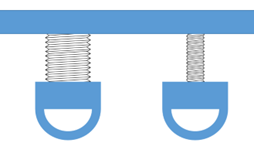One of the most frequent mistakes made when talking about forces is to use the words “load” and “stress” interchangeably, as if they mean the same thing. They don’t.
Simply put:
LOAD is in pounds; STRESS is in pounds per square inch.
So, there are two elephants – one in sneakers, one in stiletto high heels. Both elephants weigh the same. However, as they approach the watering hole, the elephant in stilettos starts having problems, as her heels keep sinking into the ground. Why?
Well, since they weigh the same, we know that the total amount of load (pounds) they put on the ground is exactly the same. However, the better-looking elephant (the one in the heels) is concentrating that load onto a much smaller area (pounds per square inch), so the stress on the ground is much higher where she steps.
In the world of equipment and gaskets, Load and Stress come into play with both the studs and the gaskets.
STUDS
The limit on studs is always given in terms of stress. If you look at the “Stud Data” tab on the Exchanger Gasket Workbook, you’ll find a table listing the “Yield Strength” of various stud materials. This value is a stress value, and is given in pounds per square inch, or “psi”. You’ll see that all B7 studs up to 2-1/2” diameter have a minimum yield strength (We’ll get into what that means later) of 105,000-psi.
Let’s take two studs – one 5/8”, and one 1-3/4” – and look at how they relate in terms of stress and load. Since they are both B7 material, and both are less than 2-1/2” diameter, they can both be stressed to 105,000 pounds per square inch. Imagine these studs screwed into a heavy I-beam on one end, with a special nut with a clevis on the other end, as shown in this sketch.

How much weight (Load) would we have to hang from each of the clevises in order to reach 50,000-psi stress in the stud? Clearly, the larger stud will take a lot more weight in order to get to the same stress.
The relationship between stress and load in a stud is determined by the “Tensile Stress Area” of the stud. This is the effective cross-sectional area of the stud in tension. The stress within the stud is equal to the total load on the stud divided by the tensile stress area:
Stress = Load / Tensile Stress Area
and:
Load = Stress * Tensile Stress Area
Since “load” is given in pounds, and “tensile stress area” is in square inches, the units of stress are pounds per square inch.
The Tensile Stress Area of the stud can be found on the “Stud Data” page of the Exchanger Gasket Workbook. Looking up the studs found in our example, we find that the tensile stress area of the 5/8” stud is 0.226 square inches, while the tensile stress area for the 1-3/4” stud is 2.081 square inches. From the equations above we can compute:
For the 5/8” stud: 50,000 * 0.226 = 11,300 pounds
For the 1-3/4” stud: 50,000 * 2.081 = 104,050 pounds
So, we would have to hang almost 10 times as much weight from the larger stud just to have the same stress as the smaller stud. Stated differently, the stress is the same, but the load is higher because the cross-sectional area of the stud is so much greater.
Essential Thought Sequence:
In considering gasket applications, we almost always need to be thinking in terms of gasket stress – the compression in pounds per square inch on the gasket. However, the gasket stress always comes from the stud stress. To get from the one to the other, we need to go through the following steps:
- Convert stud stress to stud load by using the tensile stress area.
- Multiply the individual stud load by the number of studs to get the total load being transferred to the gasket.
- Divide this total load on the gasket by the number of square inches (area) of the gasket being squeezed to determine the stress (pounds per square inch) of the gasket.
This simple conversion from stud stress to stud load, and back from stud load to gasket stress becomes second nature as we work with gasket sealing issues.